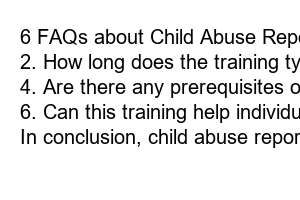아동학대 신고의무자 교육
Title: Child Abuse Reporter Training: Empowering Individuals to Protect Children
Introduction:
Child abuse is an alarming issue that continues to plague societies worldwide, causing irreparable harm to innocent lives. To combat this grave problem, it is essential that individuals are equipped with the necessary skills to identify and report cases of child abuse. In this blog post, we will explore the benefits and importance of child abuse reporter training, highlighting how it plays a pivotal role in safeguarding vulnerable children.
1. The significance of Child Abuse Reporter Training:
Child abuse reporter training provides participants with a comprehensive understanding of various forms of child abuse, such as physical, emotional, and sexual abuse, neglect, and exploitation. By raising awareness about the signs and symptoms of abuse, training empowers individuals to become proactive protectors of children’s well-being.
2. Developing Observational Skills:
Through child abuse reporter training, individuals learn how to enhance their observational skills, enabling them to recognize indicators of abuse even when children might be unable to articulate their distress. This training equips participants with the ability to detect subtle behavioral changes or physical signs that may signal an abusive situation.
3. Effective Reporting Techniques:
Training programs teach participants the importance of promptly reporting any suspicion or evidence of child abuse. By familiarizing individuals with the appropriate authorities to contact, the necessary steps to follow, and the significance of accurate documentation, child abuse reporter training ensures that potential cases are swiftly addressed and children are protected.
4. Legal Obligations and Confidentiality:
Child abuse reporter training educates individuals about their legal obligations in reporting suspected cases of abuse. Participants also gain insights into maintaining confidentiality while fulfilling their responsibility to report. Such knowledge helps individuals navigate challenging ethical dilemmas and ensures that the reporting process remains within legal boundaries.
5. Building Trust and Compassionate Reporting:
As part of reporter training, participants learn how to approach the sensitive topic of child abuse with empathy and compassion. This fosters an environment where children feel safe to disclose their experiences. Training emphasizes the significance of active listening, supportive communication, and avoiding judgement, thus promoting trust and paving the way for effective intervention.
6. Collaboration and Resources:
By engaging in child abuse reporter training, individuals become part of a larger community dedicated to the protection of children. Training programs encourage collaboration between various stakeholders, such as law enforcement agencies, social workers, healthcare professionals, and educators, facilitating a coordinated response to reported cases. Participants also gain access to resources and support networks that aid them in their advocacy for children’s rights.
6 FAQs about Child Abuse Reporter Training:
1. Who can participate in child abuse reporter training?
2. How long does the training typically last?
3. Is this training available online?
4. Are there any prerequisites or qualifications required?
5. How does reporter training benefit professionals working with children?
6. Can this training help individuals recognize the signs of child abuse in their own family?
In conclusion, child abuse reporter training is a vital tool that equips individuals with the knowledge, skills, and confidence needed to protect vulnerable children. By raising awareness, enhancing observational abilities, and promoting effective reporting techniques, training empowers individuals to become proactive guardians and make a significant impact in safeguarding children’s welfare. Together, we can create a society where every child grows up safe and secure.

